Yak-9, A Soviet Rival to P51 Mustang?
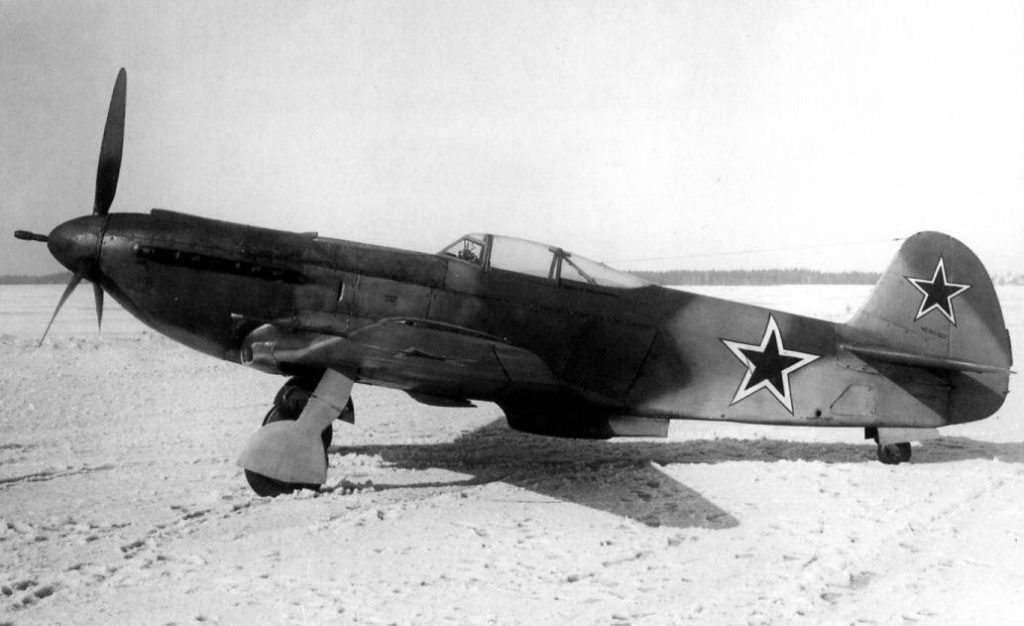
Yak9 Fighter in the Winter, on a snowy runway
The Yak-9 was a logical evolution of the Yak-1 and Yak-7 fighters. From a constructive point of view, it was a further development of the Yak-7. The use of metal made it possible, in particular, to significantly reduce the mass of the structure, and to use the gain either to increase the fuel supply, or to equip the aircraft with more powerful weapons and more diverse special equipment.
The Yak-9 was the most produced fighter of the Soviet Air Force during the Great Patriotic War. In the middle of 1944, the Yak-9, Yak-9T and Yak-9D planes in total were more than all other fighters in service combined, and they largely replaced the Yak-1 and Yak-7B on the main fronts. Yak-9 production at plant N153 reached 20 aircraft per day.
The Yak-9 was produced at three large factories (No. 82 in Moscow , No. 153 in Novosibirsk and No. 166 in Omsk ), took part in all operations of the Soviet Army , starting with the Battle of Stalingrad. All modifications of the fighter had excellent flight and technical characteristics, did not have significant design or operational defects leading to accidents.
The aircraft was extremely simple in design and adapted for production in wartime conditions. Almost all the materials from which it was built were produced in the places of its manufacture.
The first production aircraft was the Yak-9 with the M-105PF engine. The Yak-9 with the M-105PF engine and the VISH-61P propeller was a front-line fighter. It was a production aircraft, the prototype for which served as a lightweight version of the Yak-7DI aircraft. The Yak-9 had a number of differences from the last, the main of which are as follows: the fuel supply and the number of gas tanks were reduced, respectively, from 500 kg and four tanks to 320 kg and two tanks -9 they were absent); oil reserve reduced from 50 to 26… 30 kg; the bomb racks for the external suspension of bombs were removed.
The armament of the Yak-9 was similar to that of the Yak-7DI – one ShVAK motor-gun with 120 rounds of ammunition and one (left) synchronous UBS machine gun with 200 rounds of ammunition. The flight weight in comparison with the lightweight version of the Yak-7DI increased to 2870… 2875 kg, which was mainly due to the lower culture of production and less stringent mass control at serial plants compared to the experimental production of the OKB A.S. Yakovlev.
The Yak-9 was very maneuverable both vertically and horizontally, easy to control. For example, in combat on verticals, the Yak-9 got on the tail of the Me-109F after the very first combat turn , and in combat on horizontal lines – after 3-4 turns.
For the first time in hostilities, the Yak-9 took part during the Soviet counteroffensive at Stalingrad in the second half of December 1942.
In June 1943, in the Kursk region, on serial Yak-9 aircraft, due to the lack of mastery of production technology, there were several cases of separation of the wooden skin from the wing frame in flight. This defect was eliminated as it appeared by the teams of the OKB and serial factories directly in the combat units. In May 1944, on the Yak-9M and subsequent modifications, this defect was finally eliminated.
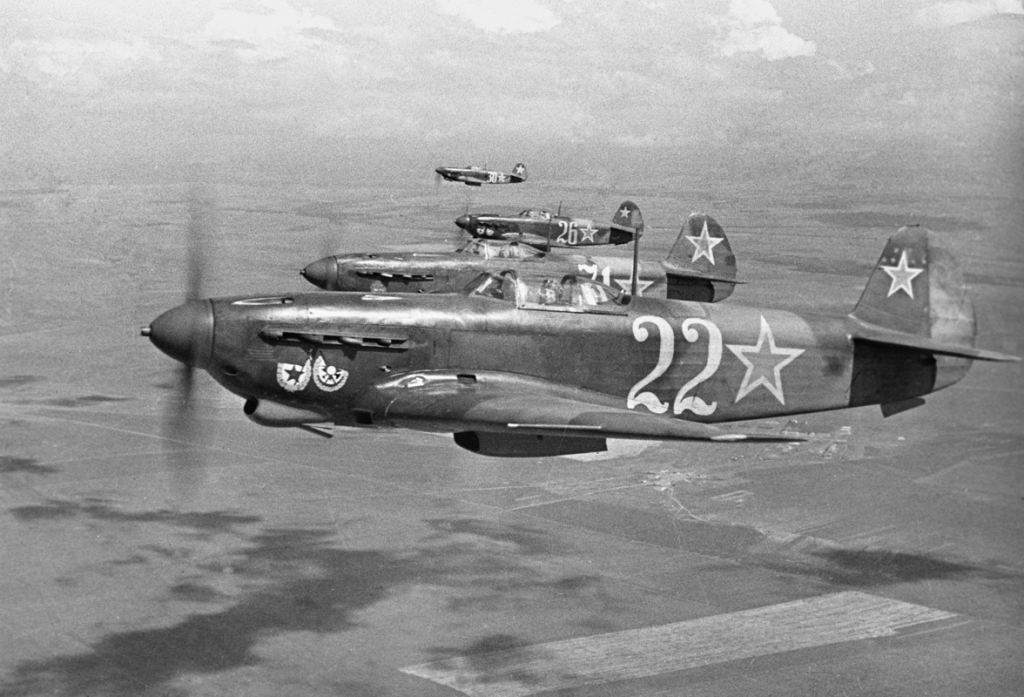
Formation of Yak 9 Fighters
Yak9 Evaluation
Often, Soviet fighters of the pre-war generation are compared with the Bf 109E , on the basis of which it is concluded that the Yak-1, MiG-3 and LaGG-3 were superior to the German fighter in terms of their characteristics. However, serial production of the E began in 1939, and before the attack on the USSR, two-thirds of the Luftwaffe’s fighter groups concentrated on the western borders of the Soviet Union switched to Bf 109F-1 in whole or in part. In the fall of 1941, the Bf 109F-2 appeared at the front, surpassing the Yak-1 with the M-105PA engine in all respects.
In the fall of 1941, research air battles with the Bf 109F-2 were conducted at the Air Force Research Institute. Due to combat damage, the German fighter landed right on the field of the Tushino airfield. At low levels, the Messerschmitt overtook the Yak-1 by 30 km / h. At an altitude of 1000 m, the German fighter had a slight advantage in vertical and horizontal maneuvers; at an altitude of 3000 m, the Yak-1 and the Messerschmitt were in equal conditions. At an altitude of 5000 m, the Yak-1 had a clear advantage both in maximum speed and in vertical and horizontal maneuverability. However, on the Messerschmitt, which took part in the battle, at altitudes above 2750, the engine did not gain power due to an unregulated injection system. The head of the Air Force Research Institute, General Fedorov, in a letter to A.S. Yakovlev dated December 24, 1941, wrote that “at the present time we do not have a fighter with flight and tactical data,the best or at least equal to the Me-109F. ”
The situation was partly leveled off with the appearance of the Yak-1 with the forced M-105PF engine, which surpassed the speed of the five-point Bf-109G in the entire range of heights from the ground up to 5000 m; The Yak-1 overtook the three-point “Messerschmitt” at altitudes up to 2000 m, above the German aircraft flew faster, and at seven kilometers the difference in speed was already 96 km / h. However, the Bf 109G had the worst aerodynamics compared to the F, and in maneuverability on a bend, the Yak-1 surpassed the Messerschmitt at altitudes up to 5000 m. The Yak-7 had the same advantages and disadvantages as the Yak-1 – it was superior to the Messerschmitt “On the horizontal lines and in the climb at low and medium heights, he had practically no advantage in maximum speed and was inferior in most parameters at high altitudes.
The new Yak-9 and especially the Yak-3 were not inferior to the Messerschmitts at low and medium altitudes.
The FW-190 fighter was considered a lighter enemy on the Eastern Front than the Bf 109. The Yak-1 and Yak-7 were superior to the Focke-Wulf in horizontal and vertical maneuverability in the altitude range up to 5000 m.
In terms of armament, the Yak-1 was not inferior to the Bf 109F, but the appearance of the Gustav , not to mention the FW-190 , undermined this balance. To some extent, the situation was corrected only by the Yak-9T, but this was not an aircraft for the average pilot. Attempts to adequately arm the Yak did not lead to convincing results. By the end of the war, it was believed that the fighter should carry three or four cannons of 20-30 mm caliber, the only exceptions were American aircraft, which had extremely powerful machine-gun armament, and the Yak. True, the three-gun La-7 did not become a mass fighter either, but two guns were still better than a cannon and a machine gun. The under-equipping of “Yakov” was noted by many famous pilots, in particular, the Soviet Ace: A. I. Pokryshkin.
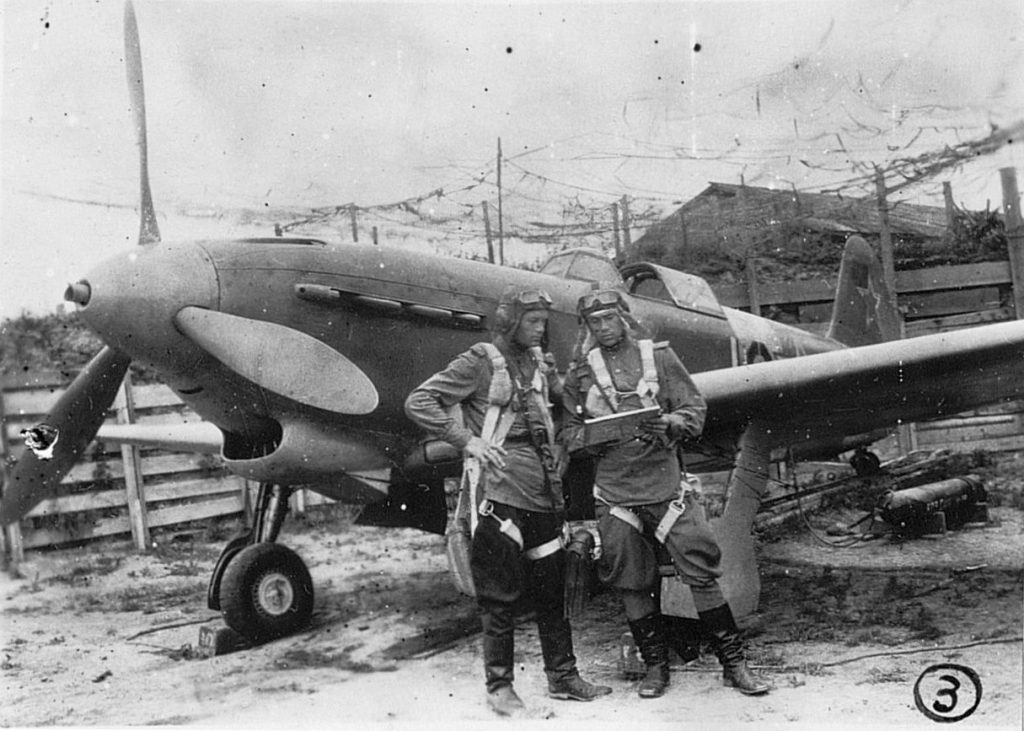
Soviet Pilots with Yak9 Fighter





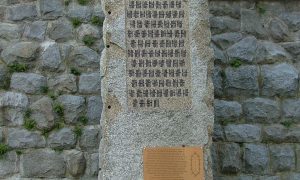

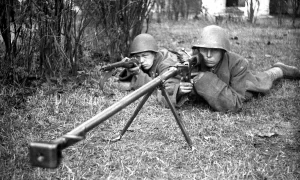





Pingback: Air Battle over Nis - WW2 - Real History Online